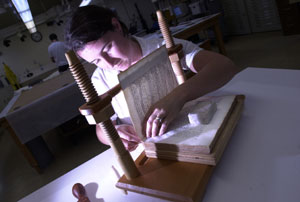|
HOME | SEARCH | ARCHIVE |
|
Protectors of the written word
Library’s conservators safeguard books for the benefit of future generations
![]()
By D. Lyn Hunter, Public Affairs
| |  Heather Nicholls repairs a first-edition copy of Isaac Newton's "The Method of Fluxions" at Doe Library's preservation lab. The book dates from 1736. Noah Berger photo |
29 November 2001
|
Books are the life-blood of Berkeley. And with the Library spending nearly $10 million on new acquisitions each year, they are among the campus’s most valuable resources. How are they protected, though, from normal wear and tear, aging and handling by countless library patrons? The guardians are 21 unsung heroes in the Library’s preservation department, charged with the monumental task of safeguarding the collections from fire, theft and damage. “The work of the department is so crucial, especially in this time of reduced resources,” said University Librarian Thomas Leonard. “Taking care of this priceless heritage, so that materials are available to new generations of students and researchers, is of utmost importance.” Among the preservation department’s most critical tasks is the conservation of books, which increases the life span of each literary investment. Highly skilled conservators, using deft hands and volumes of patience, repair tomes grown weary with use. “The challenge is to do whatever is necessary to fix a book so it can continue to provide service ,” said Barclay Ogden, head of the department. “Optimizing longevity is the goal; we hope to get a century of additional use out of a repaired book.” A book finds its way to the preservation department when a librarian determines it can’t be used again without suffering damage, said Ogden. More than 10,000 books each year are repaired or rebound. Many are sent to the UC Bindery in the Marchant Building on San Pablo Avenue for binding. But those that need a little more tender loving care — books with loose pages, food or water stains, ripped covers or the occasional dog chewing — head to the preservation lab, which is tucked in the basement of Doe Library. Using needle and thread, adhesives, pigments, cloth, paper and other materials, the conservation staff restores the books to their former glory. Work can take anywhere from a few hours to two weeks, depending on the extent of the damage and the age and value of the book. A recent project for Heather Nicholls, a conservation technician, involved an old Asian book with a cover that was disintegrating, the spine hanging on by a thread. “I carefully removed the original cloth spine, dyed new linen the same color as the original, then adhered the old material on top of the new spine,” she explained. “We find ways to re-incorporate the original material whenever possible.” Nicholls spent more than 10 painstaking hours restoring the book, but she finds this detailed work very satisfying.“Each project is so different and presents a unique set of challenges,” Nicholls said. “The variety keeps the work exciting for me.” Fellow conservation technician Lorna Kirwan is working on an even older — a third-century B.C. Egyptian papyrus decorated with Greek writing and used to stuff crocodile mummies. “Since 1949, the papyrus has been stored in plastic sleeves, but the static electricity is destroying the delicate fibers,” she said. “I’m carefully remounting each piece between two plates of glass, which will better protect them.” Microfilming is another method the department employs to preserve information. So is digital scanning, as it enables the materials to be available to a broader audience via the Web. But the technology is considered too risky without microfilm backups. “Computer software can become obsolete very quickly, and there is also the risk of accidental corruption. A virus could wipe out a whole digital collection,” said Ogden. “We prefer to use good old-fashioned microfilm, which can last more than 500 years.” While no one denies the importance of the preservationists’ work, it is difficult to take care of so many books with such a small staff, Ogden said. “We have to focus our attention on the books that are used most often, but there are so many others that require work.” Leonard said he is committed to building up the “critical mass” of conservators required to stay on top of repairs, despite looming budget cuts. Public interest in preserving original materials is at an all-time high, he said. As an example, Cal’s Class of ’56 has earmarked fundraising honoring its 40th and 45th reunions for preserving the Library’s rare and circulating books. The class hopes to leave a legacy of $1 million for the effort by the time its 50th reunion rolls around in 2006. “We’re in the age of the artifact,” said Leonard, citing the popularity of eBay, the Antiques Roadshow and the scrapbooking craze. “People like to get their hands on things, they want the experience of touching precious items.”
Home | Search | Archive | About | Contact | More News
Copyright 2000, The Regents of the University of California.
Produced and maintained by the Office of Public Affairs at UC Berkeley.
Comments? E-mail berkeleyan@pa.urel.berkeley.edu.